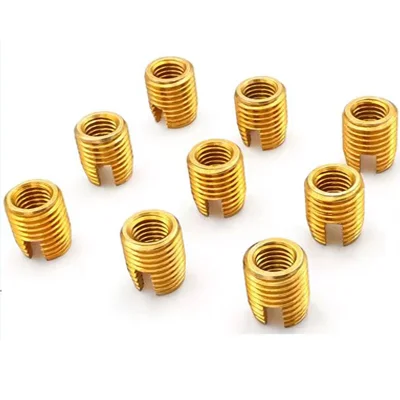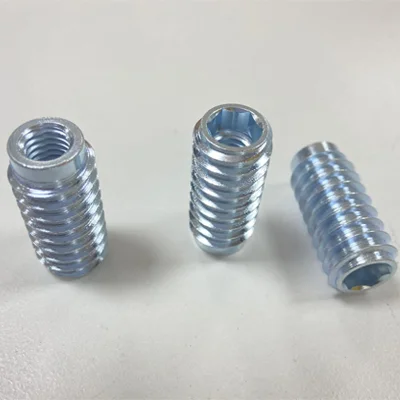caTEGORIES
Tags
How to Avoid Common Mistakes When Installing Threaded Inserts Straight

Posted: June 12, 2025
Categories: News
Tags: news
Threaded inserts are vital parts in building and fixing things. They create strong, lasting threaded connections in materials like wood, plastic, and metal. These inserts make weak materials stronger, resist shaking, and make repairs easier. They are widely used in industries like aerospace, automotive, and electronics. This article explains the types, uses, and best ways to install threaded inserts. It also covers new tools that make the process more accurate and efficient. Whether you’re a professional or a DIY fan, learning about threaded inserts helps you build stronger, longer-lasting projects.
What Are Threaded Inserts and Their Uses?
Threaded inserts are small, tube-shaped parts that add sturdy threads to materials that might not hold screws or bolts well. They work in wood, plastic, and metal to make connections stronger. These inserts are critical in fields like automotive, aerospace, furniture making, and electronics, where reliable threads are a must. They spread stress evenly and prevent wear when parts are assembled and taken apart repeatedly. This makes products last longer.
Types of Threaded Inserts and Their Features
Threaded inserts come in different kinds, each made for specific jobs:
- Helical Inserts: These are flexible and tough. They’re often used in aerospace and automotive fields because they handle shaking well.
- Press-Fit Inserts: These are simple to install without pre-threading the hole. They’re great for plastics.
- Self-Tapping Inserts: These cut their own threads as you screw them into softer materials like wood or plastic.
- Heat-Set Inserts: These are used in plastics. You heat them and press them into place for a strong hold.
- Ultrasonic Inserts: These use sound waves to melt plastic around them for a tight fit.
Each type is chosen based on the material, the strength needed, and the environment it will face.
Why Use Threaded Inserts in Different Industries?
Threaded inserts bring many benefits:
- Stronger Builds: They stop threads from wearing out in soft materials.
- Easy Fixes: You can replace parts without harming the base material.
- Better Stress Spread: They share weight across a larger area, reducing damage.
- Shaking Resistance: Some types stay tight even when things vibrate.
- Works in Many Materials: They suit metals, plastics, and wood.
These advantages make threaded inserts key for industries needing precise, high-quality work.
How Do You Prepare for Installation?
Why Is Picking the Right Insert Important?
Choosing the correct insert is critical for great results. You need to think about:
- The material you’re working with.
- How much weight the insert must hold.
- Conditions like water or extreme heat.
- Whether the part will move or stay still.
Picking the wrong insert can cause it to sit crooked or fail when under pressure.
What Materials and Tools Do You Need?
Tools for Accurate Installation
To install inserts properly:
- Use a drill bit that fits the insert’s size exactly.
- Use tools that control tightness to avoid screwing too hard or too softly.
- For plastics, consider special tools like heat-set or ultrasonic applicators.
Products for Good Preparation
For drilling, use bits made for threaded inserts. These ensure the hole is the right size and lined up correctly.
What Are Common Installation Mistakes?
How Can You Stop Misalignment?
Misalignment happens when the insert isn’t straight with the surface. This can come from bad hole preparation or using tools wrong.
Ways to Keep Inserts Straight
Using alignment jigs or guides helps keep inserts straight every time.
What About Tightness Issues?
Screwing too hard can harm the insert or material. Screwing too lightly makes the hold weak.
Tools to Avoid Tightness Errors
Tools with tightness control, set for your job, take away guesswork.
Why Does Hole Size Matter?
A hole that’s too big or too small can cause loose fits or need too much force to insert. This hurts performance.
Tips for Correct Hole Size
Always check the maker’s instructions for hole size. Precision drill bits help you follow these rules.
Step-by-Step Guide to Installing Threaded Inserts Straight
Preparing the Surface and Material Before Installation
Before you start, get the surface and material ready. This ensures a tight, secure fit. Pick a drill bit that matches the insert’s size. The right size prevents loose or overly tight fits.
Clean the surface well. Remove dirt, oil, or bits of material that could cause problems. For wood or plastic, use special drill bits made for these materials. For metal, smooth out sharp edges in the hole with a deburring tool. This helps with alignment.
Techniques for Straight Insertion with Hand Tools
Getting inserts straight is tricky, especially with hand tools. The key is keeping everything lined up.
QEWIT’s high-quality hand tool kits are made for this job. They include guides and tightness controls for accuracy. These tools make the process easier, even without fancy machines. QEWIT also offers custom tools for specific needs, ensuring every job is efficient and precise.
Using Power Tools for Fast, Accurate Insertion
Power tools make installing inserts quicker, especially for hard materials or many inserts. But you must use them right.
QEWIT’s power tools have adjustable tightness settings. This prevents screwing too hard or too soft. Some models also have built-in guides to keep inserts straight. These are great for factories where speed and accuracy matter most.
Post-Installation Best Practices
Checking Installed Inserts for Quality
After installing, check the inserts carefully. Look for straight alignment, a tight fit, and no damage.
Tips to Make Threaded Inserts Last Longer
To keep inserts working well:
- Don’t screw bolts or screws too tight.
- Check threads regularly for wear or damage.
- Use lubricants if the maker suggests them.
These steps ensure inserts perform reliably for a long time.
Innovations by QEWIT in Threaded Insert Technology
Advanced Features in QEWIT Products That Reduce Errors
QEWIT’s clever designs make installation easier. Features like self-aligning threads and strong-grip surfaces lower the chance of mistakes. These improve both ease of use and performance.

How QEWIT Products Improve Efficiency and Precision in Factories
In busy factories, time and accuracy are crucial. QEWIT’s advanced tools help. Products with quick-install features and compatibility with automated systems speed up work while keeping high precision.
FAQs
Q1: What are common mistakes when installing threaded inserts?
A: Mistakes include crooked inserts, wrong hole sizes, and bad tightness control.
Q2: Can power tools be used for all threaded inserts?
A: Power tools work for most inserts, but it depends on the material and insert type. Check the maker’s instructions.
Q3: How do I pick the right threaded insert for my project?
A: Think about the material, weight it needs to hold, conditions like heat or water, and how the part will be used.


